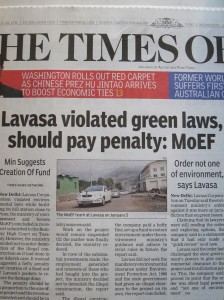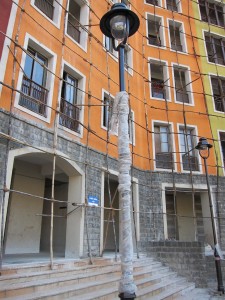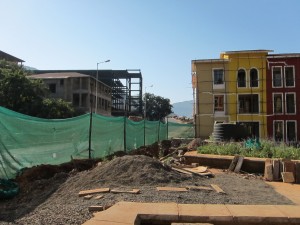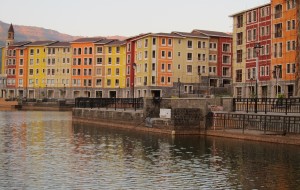A town with no ghosts
Before we came to Lavasa, I tried to research it online. Lavasa is a new planned community in the hills above Pune in Maharashtra, the brainchild of a billionaire industrialist in the first phase of its development. Unsurprisingly, the project is under public scrutiny for violating environmental building codes—or for not lining the right pockets. Lavasa is also, I later learned, the largest construction site in the world, a city literally being built from the ground up. 23,000 acres, 12,000 workers, 600,000 trees felled. Future population: 400,000.
The information was scant. All I could find were a few spun phrases about this new idyllic community and a photograph of one row of brightly-colored lakeside townhouses, their lights reflected in the water.
After I found that same single photo on three or four websites, I started to wonder if the place actually existed or if I was looking at some architect’s diorama, or even a photo of some city in Italy that was Lavasa’s inspiration.
I wasn’t so far off. One of Lavasa’s main streets is called Portofino. The row of townhouses from the photo exists, but most of the hundreds of buildings along the lakefront and lining the hills are only half-built. The site reminded me of a video I saw of Six Flags New Orleans post-Katrina, everything rusted, fraying, and abandoned. Lavasa is the opposite: a town without ghosts, waiting to be inhabited. I walked up staircases that ended abruptly in piles of sand. The streetlights are still covered in bubble wrap.
No one lives in Lavasa. A few hotels are up and running to serve executives who come for meetings (many about Lavasa itself), so there are the hotel staff and the construction workers, but Lavasa isn’t being built for them. It’s meant for a wealthy elite, and, apparently, a secular one: the city plan doesn’t include a temple. Lavasa, population zero.
I went to the “Lavasa Experience Zone,” their version of a Chamber of Commerce, to ask what there was for me to do while A was in a meeting (discussing Lavasa) all day. A security guard held open the door for me and I walked into a lobby that had all the trappings of a functioning office building—desks, brochures, squeaky and uncomfortable-looking pleather couches—except for employees.
I finally found the information desk, which was inexplicably on the fourth floor. They didn’t have a map of Lavasa, but they did welcome me to stick around for the 11 a.m. showing of the 1.5 hour promotional “3D experience” film on Lavasa, or make the trip 7km up the road to the bamboo factory (which is technically in a different village) where the locals displaced by the project were now employed. Lavasa simply isn’t real yet, though its employees have been well-trained to convince you that it is.
There is one block of restaurants and shops that are open for a few hours each day. I ate lunch at one, Chor Bizarre, which had lovely themed seating areas inside, including an old treadle sewing machine made into a table for two and a wall collage of black and white photos of classic film stars. One of the waiters—whose nametag, like everyone’s, read “Trainee”—offered to give me the tour.
I used to work planning conferences, and this felt like visiting a Marriot: every employee comes to introduce himself, asks if my stay is pleasant and if I’ve enjoyed my meal, says he hopes I’ll consider a future visit. The staff were eager and kind, and the food was almost good, though, like the town, it still tasted faintly artificial.
Lavasa is scheduled for completion in 2025. It will certainly be beautiful, and it will probably offer the ‘new class of living’ that the brochures promise. But what will it really be like as a living city? Where will Lavasa get a soul? For now, even the developers freely admit they don’t want to live here yet. Eventually someone will have to be the first.










